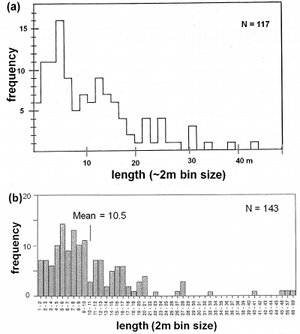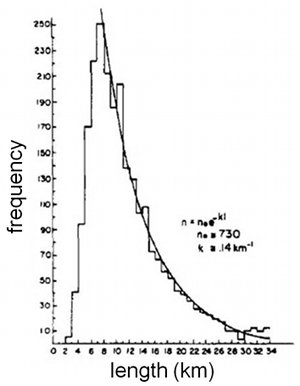| |||||||
|
|
|||||||
|
|
|||||||
| Length of Joint Zones | |||||||
|
Data on joint zone dimensions and particularly on individual joint lengths in joint zones is rather limited. Figure 1(a) shows length distribution of joint zones exposed in sandstone in Valley of Fire State Park, Nevada. The largest length measured is about 40 meters. It is informative to compare lengths of individual joints and joint zones in the same area. Figure 1(b) shows length distribution of individual joints which have a maximum value of about 20 meters. More significantly, the distribution forms are very different: while the individual joints exhibit a power law form, the joint zones are more like log-normal (please refer to the discussion under 'Geostatistical Properties' for the bases of these interpretations. Figures 2(a) and (b) show joint length distributions from the joint zones in the Entrada Sandstone cropping out at Arches National Park, Utah (Dyers, 1983) and the Pictured Cliffs Sandstone, near Durango, Colorado (Laubach, unpublished diagram), respectively. Both distributions appear to be log-normal. It has been noted by the original author that the trace lengths of the joints in the Pictured Cliffs Sandstone depends on the fracture trace orientation which is an indication that shearing took place across the zone. In both cases the maximum lengths of the joints is rather small, 44 m and 67 m, respectively, with respect to the lengths of joint zones in respective areas, which are on the order of several kilometers in Arches in Utah and several hundreds of meters at the Pictured Cliffs of Colorado. One data set from what is referred to as tensile fracture zones, or lineaments (Nur, 1982), appears to represent the upper end of length values ever reported from tensile fracture zones, with lengths on the order of a few tens of kilometers (Figure 3). Although the exact modes of these structures are not well constrained, they are likely to be sheared joint zones or fault zones as observed somewhere else (Florez et al., 2005), which will be discussed later.
| |||||||
| Reference: |
|||||||
| Dyer, J.R., 1983 Laubach, S.E., 1991 Nur, A., 1982 |
|||||||
|
Readme | About Us | Acknowledgement | How to Cite | Terms of Use | Ⓒ Rock Fracture Knowledgebase |
|||||||


